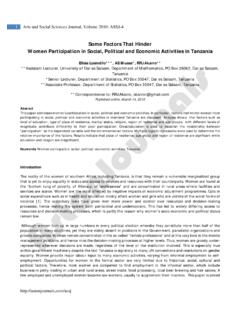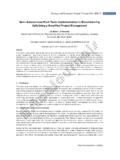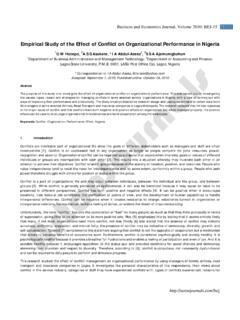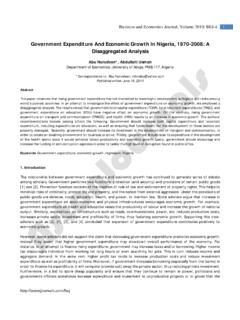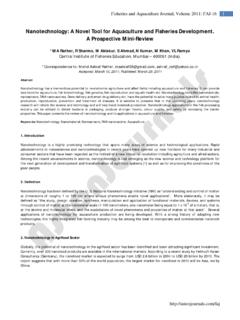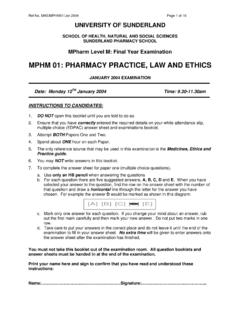Transcription of Bioremediation: Developments, Current Practices and ...
1 1 Genetic Engineering and Biotechnology Journal, Volume 2010: GEBJ-3. bioremediation : Developments, Current Practices and Perspectives Keshav Prasad Shukla, Nand Kumar Singh, Shivesh Sharma*. Department of Applied Mechanics (Biotechnology), Motilal Nehru National Institute of Technology, Allahabad (UP), India. *Correspondence to: Shivesh Sharma, Published online: January, 2010. Abstract Environmental contamination due to anthropogenic and natural sources is increasing day by day because of increase in population, industrialization and urbanization. The enigma for the public, scientists, academicians and politicians is how to tackle the contaminants that jeopardize the environment. Advances in science and technology, since industrial revolution has also increasingly enabled humans to exploit natural resources and cause damage to the environment.
2 The ideal solution for pollution abatement is bioremediation , the most effective innovative technology to come along that uses biological systems for treatment of contaminants. Although, this novel and recent technology is a multidisciplinary approach, its central thrust depends on microbiology. This technology includes biostimulation (stimulating viable native microbial population), bioaugmentation (artificial introduction of viable population), bioaccumulation (live cells), biosorption (dead microbial biomass), phytoremediation (plants) and rhizoremediation (plant and microbe interaction). Rhizoremediation, which is the most evolved process of bioremediation , involves the removal of specific contaminants from waste product of contaminated sites by mutual interaction of plant roots and suitable microbial flora.
3 This paper represents an exhaustive evaluation with respect to developments, Current Practices and perspectives of a variety of approaches of bioremediation . Keywords: bioremediation ; Phytoremediation; Polyaromatic hydrocarbons; Rhizoremediation. Introduction Vast number of pollutants and waste materials containing heavy metals are disposed into the environment per annum. Approximately 6 x 106 chemical compounds have been synthesized, with 1,000 new chemicals being synthesized annually. Almost 60,000 to 95,000 chemicals are in commercial use. According to Third World Network reports, more than one billion pounds (450 million kilograms) of toxins are released globally in air and water. The contaminants causing ecological problems leading to imbalance in nature is of global concern.
4 The environmentalists around the world are trying to overcome it by several means. However, they are raising their voices at international platforms regarding the depletion of natural resources; little attention is given to their words and continues to use them without caring the adverse consequences. Usually the contaminated sites are treated with traditional methods like physical, chemical and thermal processes resembling excavation and transportation. By this method, the cost of removal of 1 m3 soil from a 1-acre contaminated site is estimated as US $ million [1]. Billions of dollars are expected to be used to clean up all sites polluted with polycyclic aromatic hydrocarbon (PAHs) in coming decades [2]. Metal contamination in India is mainly due to industrial activities and it is estimated that about $3 billion are needed to remediate the metal contaminated sites alone in USA.
5 [3]. In the US alone, reinstatement of all contaminated sites will cost approximately $ trillion [4]. The bioremediation technology is cost effective, eco-friendly and alternative to conventional treatments, which rely on incinerations, volatili- zation or immobilization of the pollutants. The conventional treatment technologies simply transfer the pollutants, creating a new waste such as incineration residues and not eliminate the problem. bioremediation is an option that offers the possibility to destroy or render harmless various contaminants using natural biological activity. As such, it uses relatively low-cost, low-technology techniques, which generally have a high public acceptance and can often be carried out on site [5].
6 Compared to other methods, bioremediation is a more promising Review 2. and less expensive way for cleaning up contaminated soil and water [6]. bioremediation uses biological agents, mainly microorganisms, yeast, fungi or bacteria to clean up contaminated soil and water [7]. bioremediation , the use of living organisms to control or remediate polluted soils, is an emerging technology. It is defined as the elimination, attenuation or transformation of polluting or contaminating substances by the use of biological processes. Some tests make an exhaustive examination of the literature of bioremediation of organic and inorganic pollutants [8, 9], and another test takes a look at pertinent field application case histories [10]. Most bioremediation systems are run under aerobic conditions, but running a system under anaerobic conditions may permit microbial organisms to degrade otherwise recalcitrant molecules.
7 Most important parameters for bioremediation are i) the nature of pollutants, ii) the soil structure, pH, Moisture contents and hydrogeology, iii) the nutritional state, microbial diversity of the site and iv)Temperature and oxidation-reduction (redox- Potential) [11]. In bioremediation processes, microorganisms use the contaminants as nutrient or energy sources [12]. bioremediation activity through microbe is stimulated by supplementing nutrients (nitrogen and phosphorus), electron acceptors (oxygen), and substrates (methane, phenol, and toluene), or by introducing microorganisms with desired catalytic capabilities [13, 14]. Plant and soil microbes develop a rhizospheric zone (highly complex symbiotic and synergistic relationships) which is also used as a tool for accelerating the rate of degradation or to remove contaminants.
8 Groundwater is one of the most vital sources of drinking water on earth. However, in the past few decades, it has been contaminated with petroleum hydrocarbons, which leaked from underground storage tanks. These organic compounds have caused serious public concern because benzene, toluene, ethylbenzene, and xylene (BTEX) are ubiquitous pollutants hazardous to human health [15]. In situ bioremediation technology is a widely used technology that can clean up BTEX-contaminated sites, indigenous microorganisms to enhance biodegradation of organic constituents in the subsurface. Bacteria have huge catabolic possibility for remediating wastes; however, the interactions between bacteria and pollutants are complex and suitable remediation does not always take place.
9 Hence, molecular approaches are being applied to enhance bioremediation . The recent developments are taking place in bioremediation by utilizing rhizoremediation, protein engineering, metabolic engineering, whole-transcriptome profiling, and proteomics for the degradation of recalcitrant pollutants such as chlorinated aliphatic and polychlorinated biphenyl as well as for binding heavy metals [16]. Cell surface expression of specific proteins allows the engineered microorganisms to transport, bio- accumulate and/or detoxify heavy metals as well as to degrade xenobiotics [17]. Objectives of this Review Explore the Current concepts of bioremediation . Provide an insight in to the role of various developed processes like rhizoremediation and major controls that may be used for their management in degradation of inorganic and organic soil pollutants.
10 Highlight the limitations and challenges associated with the various developed processes of bioremediation . development of bioremediation bioremediation techniques are divided into three categories; in situ, ex situ solid and ex situ slurry. With in situ techniques, the soil and associated ground water is treated in place without excavation, while it is excavated prior to treatment with ex situ applications. Selection of appropriate technology among the wide range of bioremediation strategies developed to treat contaminants depends on three basic principles , the amenability of the pollutant to biological transformation (Biochemistry), the accessibility of the contaminant to microorganisms (Bioavailability) and the opportunity for optimization of biological activity (Bioactivity) [18].
